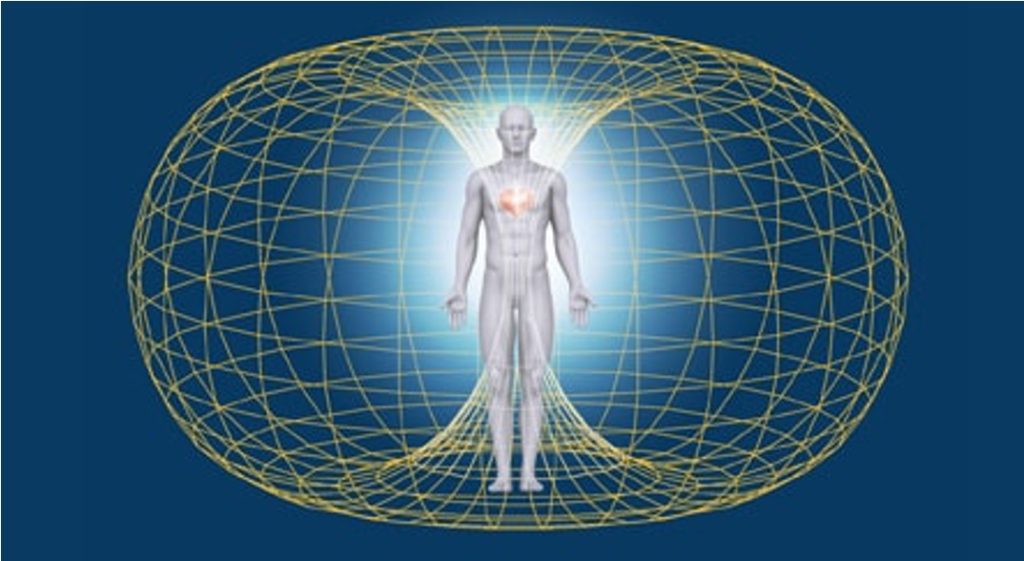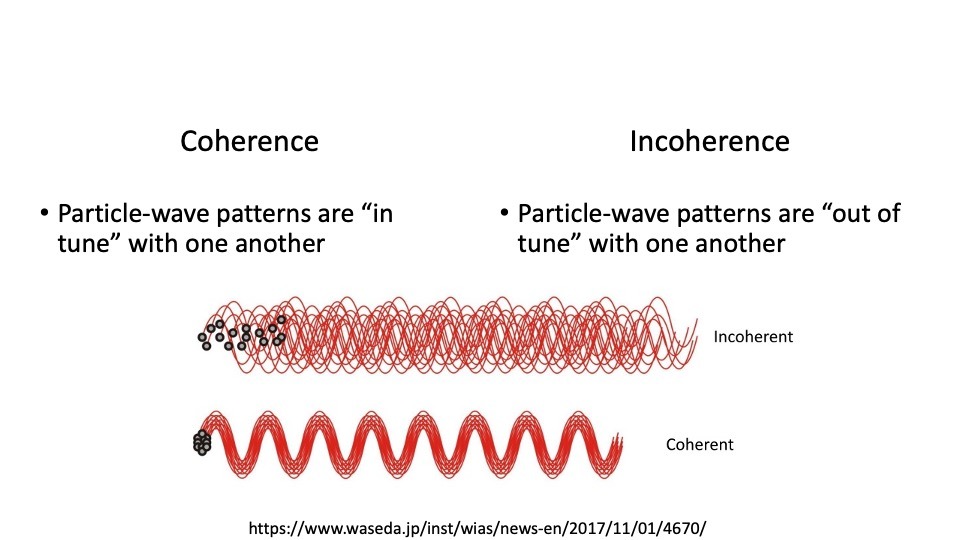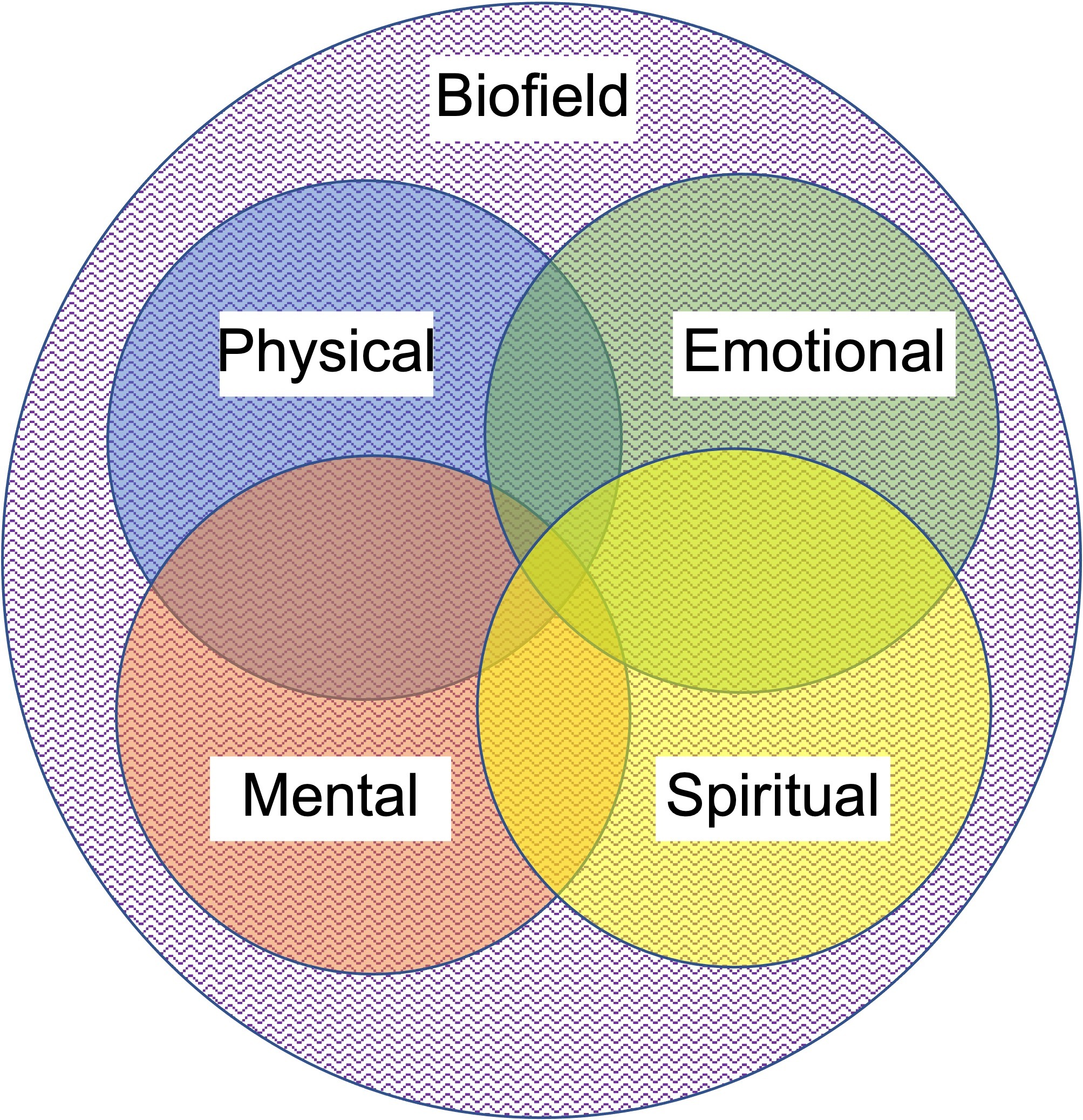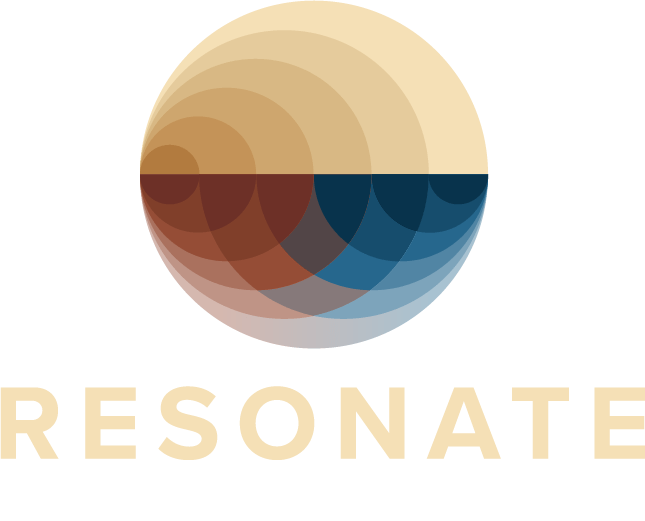
The human body is composed of both particles and waves. We are both matter and energy. Every particle within us is oscillating and spinning. This resonance creates energy waves and thus the human biofield. More information about this phenomenon can be accessed here.
Our particles and the corresponding energy field are essentially two sides of the same coin. They are different expressions of the same entity, You. Furthermore, they connect to every dimension of your being-the physical, emotional, mental and soul. All of your unique patterns within these domains can be accessed within your biofield.
Brief History of Biofield Recognition
In 1992, during the United States National Institutes of Health (NIH) Conference, the term “biofield” was defined as: “a massless field, not necessarily electromagnetic, that surrounds and permeates living bodies and affects the body.” In 1994, biofield therapies were officially recognized as an alternative treatment by NIH and were defined as “noninvasive, practitioner-mediated therapies that explicitly work with the biofield of both the practitioner and client to stimulate a healing response in the client.”
Some definitions of the biofield from researchers:
“An endogenously generated field, which may play a significant role in information transfer processes that contribute to an individual’s state of mental, emotional, physical, and spiritual wellbeing.” (Jain, 2015)
“An organizing principle for the dynamic information flow that regulates biological function and homeostasis. Biofield interactions can organize spatiotemporal biological processes across hierarchical levels: from the subatomic, atomic, molecular, cellular, organismic, to the interpersonal and cosmic levels. As such, biofield interactions can influence a variety of biological pathways, including biochemical, neurological, and cellular processes related to electromagnetism, correlated quantum information flow, and perhaps other means for modulating activity and information flow across hierarchical levels of biology. (Muehsam et al 2015)
The National Center for Complementary and Alternative Medicine was formed in 1998 (now referred to as The National Center for Complementary and Integrative Health (NCCIH)) and is the federal government’s lead agency for scientific research on the diverse medical and health care systems, practices and products that are not generally considered part of conventional medicine. In 2017, NCCIH had an annual budget of $130.5 million.
Biofield Patterns
Ideally, the patterns of energy waves in the biofield would be “in tune” with one another. This is referred to as coherence and is analogous to listening to a symphony. Let’s pretend that each string on an instrument represents an atom, each instrument to be a cell, each section of instruments to be an organ, and the entire symphony to represent the whole system of the body. In a well-played and conducted symphony/human system all of these parts would be in harmony and coherently synchronized with one another. On the other hand, if there are areas that are not in tune and dissonant, incoherence will manifest.

In sum, a biofield is an energy blueprint that corresponds holistically to an entire organism. It allows for rapid communication throughout the body. It is the matrix that connects our physical, emotional, mental and spiritual dimensions.

Biofield Therapies Objective
The goal of biofield therapies is to create improved coherence within the biofield so that the corresponding physical, emotional, mental and spiritual aspects of the body also become more coherent and healthy. There are currently many different types of biofield therapies. Some examples include Healing Touch (HT), Pranic healing, Reiki, Qigong, Therapeutic touch (TT), Biofield Tuning, and the Regenetics Method. Therapeutic touch is recognized in the Nursing Intervention Classification Code and in some state licensure boards as within the scope of nursing practice.
Biofield therapies are generally classified as either direct or indirect. In the direct method, the practitioner utilizes physical contact with the recipient over the targeted treatment area. Whereas in the indirect method the practitioner delivers the therapy without direct contact with the recipient. This is possible because biofield therapies work within the biofield where direct contact is not required.
Regarding utilization of biofield therapies, in the 2012 National Health Interview Survey, >3.7 million US adult citizens surveyed “have ever” seen a practitioner for energy healing therapy, and >1.6 million adults in the US reported seeing an energy healing therapy practitioner at least once in the past 12 months.
Biofield Therapy Effectiveness
There is a substantial body of evidence supporting the effectiveness of biofield therapies. In the publication “Clinical Studies of Biofield Therapies: Summary, Methodological Challenges, and Recommendations” by Jain et al (2015) over 30 published clinical trials were identified demonstrating positive effects of biofield therapies for pain in ambulatory and hospitalized patient populations with chronic pain, arthritis, and movement restriction.
Jain and Mills (2010) performed a systematic review of 66 clinical studies utilizing a variety of biofield therapies in different patient populations. The results showed that biofield therapies had strong evidence for decreasing pain intensity in pain populations and moderate evidence for improving pain intensity in hospitalized and cancer populations, decreasing negative behavioral symptoms in dementia and reducing anxiety for hospitalized populations.
Additional studies have demonstrated positive results on improving heart rate variability (HRV) and anxiety (MacIntyre et al 2008); decreasing depression; persistent fatigue; positive effects on diurnal cortisol variability in fatigued breast cancer patients compared to mock treatments or standard care (Running et al, 2015), (Fitzhenry et al, 2014); reducing depressive symptoms and blunted drop in natural killer cell cytotoxicity in cervical cancer patients (Lutgendorf et al, 2010); and improving symptoms of depression, chronic widespread pain and tenderness in patients with fibromyalgia (Sarmento et al, 2017).
A group of Physical Therapists conducted a randomized, placebo-controlled, double-blind study on the effects of Oscillatory Biofield Therapy (OBFT) on individuals with carpal tunnel syndrome (Nourbakhsh et al, 2016). OBFT involves a hands-on technique where the practitioner intentionally directs therapeutic energy to the targeted area. 30 subjects were randomly assigned to either a treatment or sham control group. Both groups received the same exact physical procedures in that they underwent 6 sessions over a two week period of the practitioner providing direct hand contact to the carpal tunnel at the wrist.
In the treatment group, the practitioner had the intention and therapeutic manipulation of the patient’s biofield whereas in the mock group there was no conscious intention to interact with the recipient’s biofield. The results showed clinically and statistically significant changes in the intensity of pain with activity, night pain (DASH questionnaire), and Functional Status Scale (FSS) between the treatment and placebo groups. There was a statistically significant reduction in the number of patients with positive results on the Phalen’s test, Tinel’s sign, and hand paresthesia in the treatment group. At a 6-month follow-up, 86% of patients in the treatment group remained pain-free and had no functional limitations.
It is reasonable to consider the potential limitations and misinterpretation of placebo-controlled randomized trials in biofield therapies. While biofield therapies may serve to increase the placebo effect (as does any potential therapeutic intervention), it does appear that biofield therapies enhance outcomes over and above sham-controlled groups, particularly for pain. Current data suggests it is unlikely that biofield therapies are reducible to placebo responses alone, but like other forms of mind-body interventions, biofield therapies may intentionally facilitate the patient’s conscious and unconscious expectations and desires in synergy with the treatment being delivered to enhance outcomes. (Jain et al, 2015)
Interdependence
The physical, emotional, mental and spiritual aspects of the human body are ultimately interconnected with one another and represented within the matrix of the biofield. Therefore, creating improved biofield coherence can in turn facilitate improved physical, emotional, mental and spiritual state of being. Likewise, facilitating a healthier physical, emotional, mental and spiritual state of being can result in improved biofield coherence. There is a bidirectional relationship between these domains of bio-matter and bio-energy.
When a physical issue or problem exists, in many cases it can be sufficient to address it at the physical level. However, in some cases, solely physical based interventions are not enough of a stimulus to create a new pattern and healing within an individual. This tends to be particularly so when there are concurrent patterns of self-limiting beliefs and emotions such as fear, anxiety and depression.
There is a plethora of scientific research that supports the connection between mental and emotional factors with physical pain and disability. (Alfvén, Grillner, & Andersson, 2017; Bunzli, Smith, Schütze, Lin, & O’Sullivan, 2017; Eckhoff, Straume, & Kvernmo, 2017; Hodges & Tucker, 2011; Lotze & Moseley, 2015; Marin et al., 2017; Racine et al., 2016;).
Within the professional landscape of Physical Therapy there is a relatively new evidence-based paradigm referred to as “Pain Science” that supports the need to educate patients about the impact that their perceptions and beliefs have on their experience of pain and function. (Dilek, Ayhan, Yagci, & Yakut, 2017; Lotze & Moseley, 2015; Marin et al., 2017; Moseley & Butler, 2015; Schabrun, Elgueta-Cancino, & Hodges, 2017). This is an invaluable tool and treatment aspect to helping individuals overcome patterns of pain and movement restriction by reducing fear and facilitating empowerment. By changing one’s beliefs about their potential for recovery in a positive context actual recovery and change may manifest. Bruce Lipton clearly supports this in his scientifically-based book, “The Biology of Belief.” (Lipton, 2015)
What is significant to note about Pain Science is that it is primarily a conscious based learning approach. Meaning, it provides awareness and a rational explanation for individuals to understand why they may hurt and be limited in function. This insight is an important component in the healing process and research, as just referenced, supports its effectiveness.
However, such a conscious based approach does not always provide enough of a stimulus for true changes to manifest within a multi-dimensional body. This is because much of the essence that creates one’s self-limiting beliefs and emotional patterns is sourced at the unconscious level.
Science has shown that our brains make decisions and take action before we are consciously aware of them. Sam Harris’s book, “Free Will” describes compelling evidence of this phenomenon supporting the idea that it is primarily our unconscious self that is directing our behavior. Taking this a step further, these unconscious patterns are ultimately encoded within our biofield which contains the informational hardware of our bodies.
Because of the power of biofield based therapies to go into the unconscious realms of the mind and body, healing shifts and the ability to learn patterns that were previously unobtainable can then become achievable. Furthermore, when you couple biofield therapies with conscious-based physical, emotional, mental and spiritual based techniques an even more powerful stimulus for permanent change is born. It is through this multidimensional integration that true healing can manifest in our conscious physical reality.
Resonate Health offers biofield therapies delivered in various formats to best suit you.
Biofield Tuning
- To Learn about the powerful biofield therapy, Biofield Tuning, go here.
- To witness a case study demonstrating Biofield Tuning’s amazing healing potential, go here.
Regenetics
- For more information about what the Regenetics method is, go here.
- To see a case study revealing the healing power of Regenetics go, here.
Have more questions about whether biofield therapies are the right healing modality for you? Jump on a quick 20 min Integrative Consulting call for guidance on your best next steps.
References
Day McKusisk, E. (2014). Tuning the Human Biofield. Simon and Schuster.
Fitzhenry, F., Wells, N., Slater, V., Dietrich, M. S., Wisawatapnimit, P., & Chakravarthy, A. B. (2014). A randomized placebo-controlled pilot study of the impact of healing touch on fatigue in breast cancer patients undergoing radiation therapy. Integrative Cancer Therapies, 13(2), 105–113.
Hammerschlag, R., Jain, S., Baldwin, A. L., Gronowicz, G., Lutgendorf, S. K., Oschman, J. L., & Yount, G. L. (2012). Biofield Research: A Roundtable Discussion of Scientific and Methodological Issues. The Journal of Alternative and Complementary Medicine, 18(12), 1081–1086.
Hammerschlag, R., Marx, B. L., & Aickin, M. (2014). Nontouch Biofield Therapy: A Systematic Review of Human Randomized Controlled Trials Reporting Use of Only Nonphysical Contact Treatment. The Journal of Alternative and Complementary Medicine, 20(12), 881–892.
Harris, S. (2012). Free Will. Free Press.
Jain, S., Daubenmier, J., Muehsam, D., Rapgay, L., & Chopra, D. (2015). Indo-Tibetan Philosophical and Medical Systems: Perspectives on the Biofield. Global Advances in Health and Medicine : Improving Healthcare Outcomes Worldwide, 4(Suppl), 16–24.
Jain, S., Hammerschlag, R., Mills, P., Cohen, L., Krieger, R., Vieten, C., & Lutgendorf, S. (2015). Clinical Studies of Biofield Therapies: Summary, Methodological Challenges, and Recommendations. Global Advances in Health and Medicine, 4(suppl), 58–66.
Jain, S., & Mills, P. J. (2010). Biofield therapies: helpful or full of hype? A best-evidence synthesis. International Journal of Behavioral Medicine, 17(1), 1–16.
Kafatos, M. C., Chevalier, G., Chopra, D., Hubacher, J., Kak, S., & Theise, N. D. (2015). Biofield Science: Current Physics Perspectives. Global Advances in Health and Medicine, 4(suppl), 25–34.
Kreitzer, M. J., & Saper, R. (2015). Exploring the Biofield. Global Advances in Health and Medicine, 4(suppl), 3–4.
Lu, D. F., Hart, L. K., Lutgendorf, S. K., & Perkhounkova, Y. (2013). The effect of healing touch on the pain and mobility of persons with osteoarthritis: A feasibility study. Geriatric Nursing, 34(4), 314–322.
Luckman, S. (2010). Conscious Healing: Book One on the Regenetics Method. Raleigh, NC: Crow Rising Transformational Media through Lulu Enterprises, Inc.
Luckman, S. (2011). Potentiate your DNA. Raleigh, NC: Crow Rising Transformational Media through Lulu Enterprises, Inc.
Lutgendorf, S. K., Mullen-Houser, E., Russell, D., DeGeest, K., Jacobson, G., Hart, L., … Lubaroff, D. M. (2010). Preservation of immune function in cervical cancer patients during chemoradiation using a novel integrative approach. Brain, Behavior, and Immunity, 24(8), 1231–1240.
MacIntyre, B., Hamilton, J., Fricke, T., Ma, W., Mehle, S., & Michel, M. (2008). The efficacy of healing touch in coronary artery bypass surgery recovery: a randomized clinical trial. Alternative Therapies in Health and Medicine, 14(4), 24–32.
Mangione, L., Swengros, D., & Anderson, J. G. (2017). Mental Health Wellness and Biofield Therapies: An Integrative Review. Issues in Mental Health Nursing, 38(11), 930–944.
Mills, P. J., & Jain, S. (2010). Biofield therapies and psychoneuroimmunology. Brain, Behavior, and Immunity.
Movaffaghi, Z., & Farsi, M. (2009). Biofield therapies: Biophysical basis and biological regulations? Complementary Therapies in Clinical Practice, 15(1), 35–37.
Muehsam, D., Chevalier, G., Barsotti, T., & Gurfein, B. T. (2015). An Overview of Biofield Devices. Global Advances in Health and Medicine, 4(suppl), 42–51.
Nourbakhsh, M. R., Bell, T. J., Martin, J. B., & Arab, A. M. (2016). The Effects of Oscillatory Biofield Therapy on Pain and Functional Limitations Associated with Carpal Tunnel Syndrome: Randomized, Placebo-Controlled, Double-Blind Study. The Journal of Alternative and Complementary Medicine, 22(11), 911–920.
Rein, G. (2004). Bio information within the biofield: beyond bioelectromagnetics. Journal of Alternative and Complementary Medicine (New York, N.Y.), 10(1), 59–68.
Rubik, B. (2002). The biofield hypothesis: its biophysical basis and role in medicine. Journal of Alternative and Complementary Medicine (New York, N.Y.), 8(6), 703–717.
Rubik, B., Muehsam, D., Hammerschlag, R., & Jain, S. (2015). Biofield Science and Healing: History, Terminology, and Concepts. Global Advances in Health and Medicine, 4(suppl), 8–14.
Rubik, B., Sun, Y., Wang, C., Dai, J., Tang, R., & Dai, J. (2010). Biophoton signal transmission and processing in the brain. Journal of Alternative and Complementary Medicine (New York, N.Y.), 139(6), 703–717.
Running, A. (2015). Decreased cortisol and pain in Breast Cancer: Biofield therapy potential. Evidence-Based Complementary and Alternative Medicine, 2015.
Sarmento, F., Tanaka, H., Cordeiro, E., & Suzuki, K. (2017). Effectiveness of Biofield Therapy for Patients Diagnosed With Fibromyalgia. Alternative Therapies in Health and Medicine.
Sun, Y., Wang, C., & Dai, J. (2010). Biophotons as neural communication signals demonstrated by in situ biophoton autography. Photochemical & Photobiological Sciences, 9(3), 315.
Swanson, C. (2011). Life Force, The Scientific Basis. Poseidia Press.
Zangari, A., Micheli, D., Galeazzi, R., & Tozzi, A. (2018). Node of Ranvier as an Array of Bio-Nanoantennas for Infrared Communication in Nerve Tissue. Scientific Reports, 8(1), 1–19.
DISCLAIMER & COPYRIGHT
This content is for informational purposes only and is not a substitute for medical advice. Please consult your medical doctor or professional if you have medical concerns.
©️ 2022 Resonate Health. This content may not be duplicated, copied or shared unless authorized.

